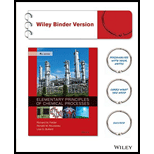
Concept explainers
Citric acid (C6H8O7) is used in the preparation of many foods, pharmaceuticals, soft drinks, and personal-care products. Although it can be recovered by concentration and crystallization from citrus juices, especially lemons, modem commercial production involves synthesis by fermentation of molasses or other carbohydrates such as glucose or fructose by the fungus Aspergillus niger (A. niger). The process involves addition of the fungus to a fermenter along with glucose, nutrients, water, and air that is bubbled through the fermentation broth After the desired conversion, the resulting liquor is processed first by filtration of the cell mass and other solids from the liquid and then recovery and purification of the citric acid by crystallization.
As part of the evaluation of a proposed continuous fermentation process, you have been asked to estimate the heating or cooling requirement associated with a fermenter that is to produce 10.0 kg of citric acid per hour. Feed to the unit includes (1) an aqueous solution that is 20.0 wt% glucose
where the coefficients of the species (a, b,....) are to be determined. Experiments on the fermentation reaction have found that 70% of the glucose consumed is converted to citric acid and that the respiratory quotient (RQ) is 0.45 (RQ = moles of CO2produced per mole of O2consumed).
The following table gives data for selected process species. Information on other species may be found in Table B.l.
| Species | MW(g/mol) |
|
|
| glucose(s) | 180 | -1006.8 | 9.9 |
| citric acid(s) | 192 | -1543.8 | 22.6 |
| ammonia(g) | 17 | -46.19 | -35 |
| cellular material(s) | 24.6 | -59.9 | — |
- Use elemental species balances to determine the coefficients in the stoichiometric equation.
Exploratory Exercises—Research and Discover
Learn your wayIncludes step-by-step video

Chapter 9 Solutions
Elementary Principles of Chemical Processes, Binder Ready Version
Additional Engineering Textbook Solutions
Process Dynamics and Control, 4e
Elements of Chemical Reaction Engineering (5th Edition) (Prentice Hall International Series in the Physical and Chemical Engineering Sciences)
C++ How to Program (10th Edition)
Database Concepts (7th Edition)
Starting Out with C++ from Control Structures to Objects (8th Edition)
Starting Out with Java: From Control Structures through Objects (6th Edition)
 Introduction to Chemical Engineering Thermodynami...Chemical EngineeringISBN:9781259696527Author:J.M. Smith Termodinamica en ingenieria quimica, Hendrick C Van Ness, Michael Abbott, Mark SwihartPublisher:McGraw-Hill Education
Introduction to Chemical Engineering Thermodynami...Chemical EngineeringISBN:9781259696527Author:J.M. Smith Termodinamica en ingenieria quimica, Hendrick C Van Ness, Michael Abbott, Mark SwihartPublisher:McGraw-Hill Education Elementary Principles of Chemical Processes, Bind...Chemical EngineeringISBN:9781118431221Author:Richard M. Felder, Ronald W. Rousseau, Lisa G. BullardPublisher:WILEY
Elementary Principles of Chemical Processes, Bind...Chemical EngineeringISBN:9781118431221Author:Richard M. Felder, Ronald W. Rousseau, Lisa G. BullardPublisher:WILEY Elements of Chemical Reaction Engineering (5th Ed...Chemical EngineeringISBN:9780133887518Author:H. Scott FoglerPublisher:Prentice Hall
Elements of Chemical Reaction Engineering (5th Ed...Chemical EngineeringISBN:9780133887518Author:H. Scott FoglerPublisher:Prentice Hall
 Industrial Plastics: Theory and ApplicationsChemical EngineeringISBN:9781285061238Author:Lokensgard, ErikPublisher:Delmar Cengage Learning
Industrial Plastics: Theory and ApplicationsChemical EngineeringISBN:9781285061238Author:Lokensgard, ErikPublisher:Delmar Cengage Learning Unit Operations of Chemical EngineeringChemical EngineeringISBN:9780072848236Author:Warren McCabe, Julian C. Smith, Peter HarriottPublisher:McGraw-Hill Companies, The
Unit Operations of Chemical EngineeringChemical EngineeringISBN:9780072848236Author:Warren McCabe, Julian C. Smith, Peter HarriottPublisher:McGraw-Hill Companies, The





